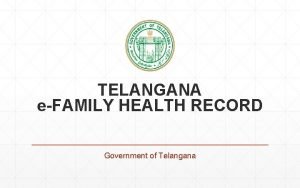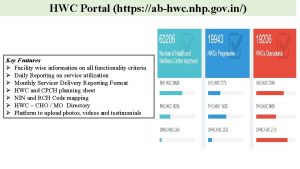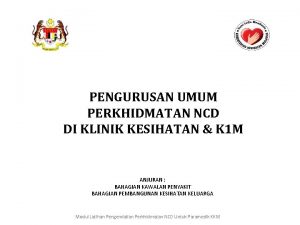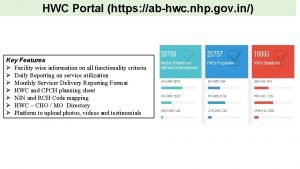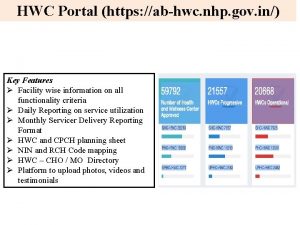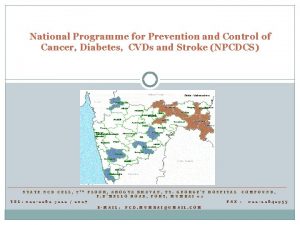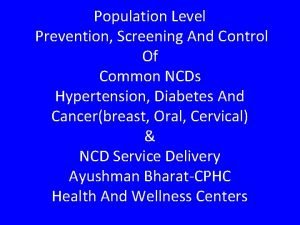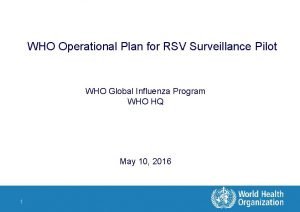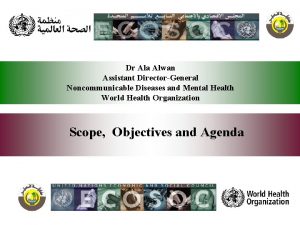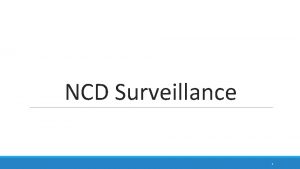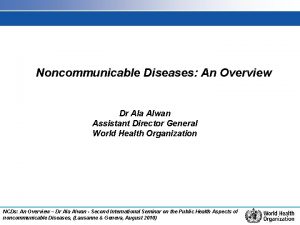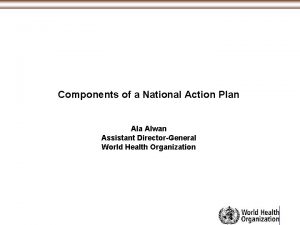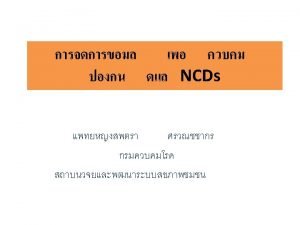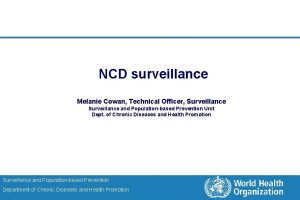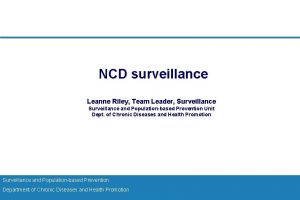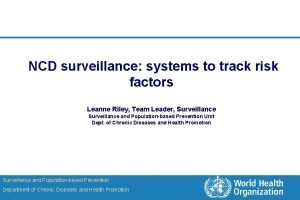NCD surveillance systems Dr Ala Alwan Assistant DirectorGeneral














- Slides: 14

NCD surveillance systems Dr Ala Alwan Assistant Director-General WHO Профилактика неинфекционных заболеваний и борьба с ними 预防和控制非传染病 Prevención y control de las enfermedades no transmisibles ﺍﻟﻮﻗﺎﻳﺔ ﻣﻦ ﺍﻷﻤﺮﺍﺽ ﻏﻴﺮ ﺍﻟﻤﻌﺪﻳﺔ ﻭﻣﻜﺎﻓﺤﺘﻬﺎ Prévention et maîtrise des maladies non Prevention and control of noncommunicable transmissibles diseases First Global Ministerial Conference on Healthy Lifestyles and NCD Control (Moscow, 28 -29 April 2011)

World Health Assembly in 2000: Global Strategy for the Prevention and Control of NCDs *Surveillance* Mapping the epidemic of NCDs First Global Ministerial Conference on Healthy Lifestyles and NCD Control (Moscow, 28 -29 April 2011) *Prevention* Reducing the level of exposure to risk factors *Management* Strengthen health care for people with NCDs

The NCD Acton Plan Six objectives: 1. Raising the priority accorded to noncommunicable diseases in development work at global and national levels, and integrating prevention and control of noncommunicable diseases into policies across all government departments 2. Establishing and strengthening national policies and programmes 3. Reducing and preventing risk factors 4. Prioritizing research on prevention and health care 5. Strengthening partnerships 6. Monitoring NCD trends and assessing progress made at country level First Global Ministerial Conference on Healthy Lifestyles and NCD Control (Moscow, 28 -29 April 2011)

NCD surveillance • The ongoing, systematic collection and analysis of data on NCD burden, risk factors and determinants. • Provides ability to track health outcomes and risk factor trends over time. • Critical for informing policy and programme development and Accurate data from monitoring progress. First Global Ministerial Conference on Healthy Lifestyles and NCD Control (Moscow, 28 -29 April 2011) countries is vital to reverse the global rise in death and disability from NCDs

Gaps and Lessons Leaned • Good progress in risk factors surveillance over the last decade but NCD surveillance systems are still generally weak in member States • No consensus on key components of an NCD surveillance system and lack of standardized indicators to monitor NCD trends at national and global levels – duplication/inconsistencies • When it exists, NCD surveillance work is not institutionalized and rarely integrated into the national health information systems of LMICs • Limited capacity in epidemiology and surveillance in Member States First Global Ministerial Conference on Healthy Lifestyles and NCD Control (Moscow, 28 -29 April 2011)

Surveillance indicators An indicator should be • • central to NCD with an established science base modifiable as a result of intervention measurable with valid tools feasible and affordable to collect practical and achievable within a country's technical capacity acceptable (culturally) policy relevant First Global Ministerial Conference on Healthy Lifestyles and NCD Control (Moscow, 28 -29 April 2011)

Framework for national NCD surveillance • Exposures – Behavioural risk factors: tobacco use, physical inactivity, harmful use of alcohol and unhealthy diet – Metabolic risk factors: raised blood pressure, overweight/obesity, raised blood glucose, and raised cholesterol. – Social determinants: education, material well being, access to health care • Outcomes – Mortality: NCD specific mortality – Morbidity: cancer incidence and type • Health System Response – Interventions and health system capacity: infrastructure, policies and plans, access to key health care interventions and treatments, partnerships. First Global Ministerial Conference on Healthy Lifestyles and NCD Control (Moscow, 28 -29 April 2011)

Core indicators for NCD surveillance - Exposure Behavioral risk factors: • Prevalence of current daily tobacco smoking among adults aged 15+ years. ) • Prevalence of insufficiently active adults (defined as % not meeting any of the following criteria: 30 minutes of moderate activity on at least five days per week or 20 minutes of vigorous activity on at least three days per week or an equivalent combination). • Prevalence of adult population consuming more than 5 grams of dietary sodium chloride per day (%). • Prevalence of population consuming less than five total servings (400 grams) of fruit and vegetables per day (%). • Proportion of all energy derived from saturated and total fats (%). • Adult per capita consumption of pure alcohol, in litres (recorded and unrecorded). Physiological and metabolic risk factors: • Prevalence of raised blood glucose among adults (defined as fasting plasma glucose value ≥ 7. 0 mmol/L (126 g/dl) or on medication for raised blood glucose) (%). • Prevalence of raised blood pressure among adults (defined as systolic blood pressure ≥ 140 mm. Hg and/or diastolic blood pressure ≥ 90 mm. Hg or on medication for raised blood pressure (%). • Prevalence of overweight and obesity in adults, adolescents and children under 5 (defined as body mass index greater than 25 kg/m 2 for overweight or 30 kg/m 2 for obesity, for adolescents according to the WHO Growth Reference and for children according to the WHO Growth Standards) (%). • Prevalence of low weight at birth (< 2. 5 kg) (%). • Prevalence of raised total cholesterol among adults (defined as total cholesterol ≥ 5. 0 mmol/l or 190 mg/dl) (%). First Global Ministerial Conference on Healthy Lifestyles and NCD Control (Moscow, 28 -29 April 2011)

Core indicators for NCD surveillance - Outcomes Mortality: - All-cause mortality by age, sex and region (urban and rural, or by other administrative areas, as available). - Cause-specific mortality data (urban and rural, or other administrative areas, as available). - Unconditional probability of death between ages 30 and 70 years from cardiovascular diseases, cancer, diabetes, and chronic respiratory diseases. Morbidity: - Cancer incidence data from cancer registries, by type of cancer. First Global Ministerial Conference on Healthy Lifestyles and NCD Control (Moscow, 28 -29 April 2011)

Monitoring exposures: Using the WHO STEPS approach Different levels of risk factor assessment: • STEP 1 – questionnaire • STEP 2 – physical measurements • STEP 3 – blood samples Three modules per Step: • Core • Expanded • Optional First Global Ministerial Conference on Healthy Lifestyles and NCD Control (Moscow, 28 -29 April 2011)

Monitoring outcomes - challenges • High quality mortality data requires long-term investment in civil registration systems. • Accurate cause of death certification is a challenge, even in high income countries. • Only limited improvements have been made in the past few decades • Strengthening vital registration systems, and causespecific mortality statistics is a key priority. First Global Ministerial Conference on Healthy Lifestyles and NCD Control (Moscow, 28 -29 April 2011)

Monitoring health system response: WHO Global Survey on Assessment of National capacity • Designed to gather information about individual country capacity to respond to NCD prevention and control. • Assessment focused on current strengths and weaknesses related to: NCD infrastructure, policy response, surveillance and health systems response and partnerships and health promotion. • 3 rd wave of surveillance – previous surveys in 2000 and 2005. A further wave planned for 2013. • 95% response rate from Member States. • Periodic monitoring of national progress would assist countries in identifying gaps in prevention and control efforts and assist with future planning. First Global Ministerial Conference on Healthy Lifestyles and NCD Control (Moscow, 28 -29 April 2011)

Monitoring health systems response % countries with specific policies, plans or strategies, 2000 - 2010 First Global Ministerial Conference on Healthy Lifestyles and NCD Control (Moscow, 28 -29 April 2011)

Conclusions • Current capacity for NCD surveillance is weak • High quality risk factor surveillance is possible even in low resourced countries • A framework, with common core indicators is essential. • Cancer mobidity data is essential for planning cancer control strategies • Sustainable surveillance systems need integration into national health information systems, with resources First Global Ministerial Conference on Healthy Lifestyles and NCD Control (Moscow, 28 -29 April 2011)





